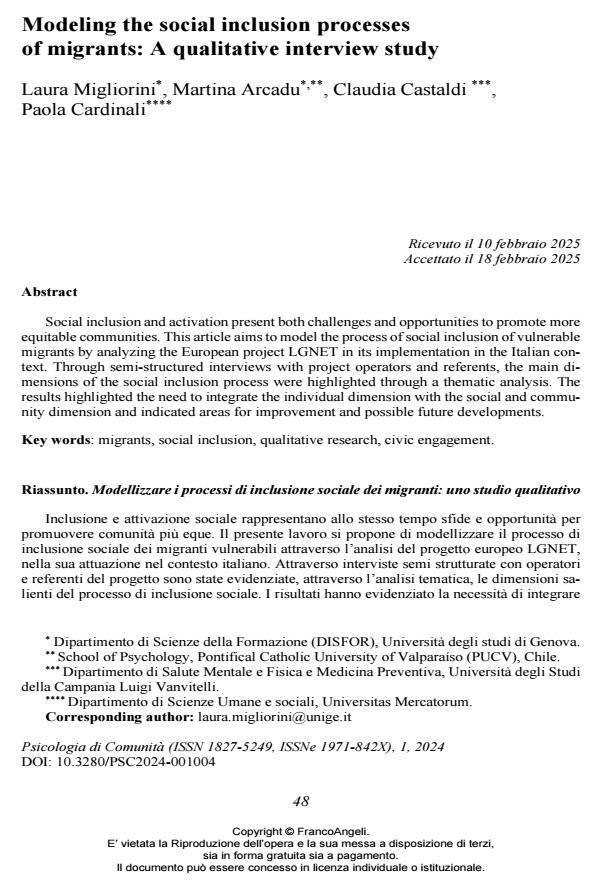Modeling the social inclusion processes of migrants: A qualitative interview study
Titolo Rivista PSICOLOGIA DI COMUNITA’
Autori/Curatori Laura Migliorini, Martina Arcadu, Claudia Castaldi, Paola Cardinali
Anno di pubblicazione 2025 Fascicolo 2024/1
Lingua Inglese Numero pagine 18 P. 48-65 Dimensione file 168 KB
DOI 10.3280/PSC2024-001004
Il DOI è il codice a barre della proprietà intellettuale: per saperne di più
clicca qui
Qui sotto puoi vedere in anteprima la prima pagina di questo articolo.
Se questo articolo ti interessa, lo puoi acquistare (e scaricare in formato pdf) seguendo le facili indicazioni per acquistare il download credit. Acquista Download Credits per scaricare questo Articolo in formato PDF

FrancoAngeli è membro della Publishers International Linking Association, Inc (PILA)associazione indipendente e non profit per facilitare (attraverso i servizi tecnologici implementati da CrossRef.org) l’accesso degli studiosi ai contenuti digitali nelle pubblicazioni professionali e scientifiche
Social inclusion and activation present both challenges and opportunities to promote more equitable communities. This article aims to model the process of social inclusion of vulnerable migrants by analyzing the European project LGNET in its implementation in the Italian context. Through semi-structured interviews with project operators and referents, the main dimensions of the social inclusion process were highlighted through a thematic analysis. The results highlighted the need to integrate the individual dimension with the social and community dimension and indicated areas for improvement and possible future developments.
Inclusione e attivazione sociale rappresentano allo stesso tempo sfide e opportunità per promuovere comunità più eque. Il presente lavoro si propone di modellizzare il processo di inclusione sociale dei migranti vulnerabili attraverso l’analisi del progetto europeo LGNET, nella sua attuazione nel contesto italiano. Attraverso interviste semi strutturate con operatori e referenti del progetto sono state evidenziate, attraverso l’analisi tematica, le dimensioni salienti del processo di inclusione sociale. I risultati hanno evidenziato la necessità di integrare la dimensione individuale con la dimensione sociale e di comunità, mettendo in luce aree di miglioramento e possibili futuri sviluppi.
Parole chiave:migranti, inclusione sociale, ricerca qualitativa, impegno civico.
Laura Migliorini, Martina Arcadu, Claudia Castaldi, Paola Cardinali, Modeling the social inclusion processes of migrants: A qualitative interview study in "PSICOLOGIA DI COMUNITA’" 1/2024, pp 48-65, DOI: 10.3280/PSC2024-001004